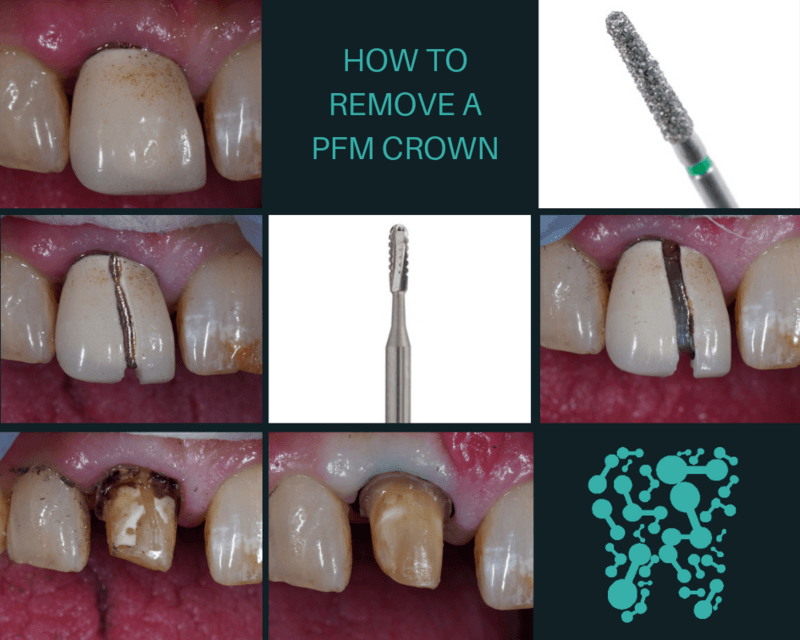
The process of removing old dental crowns is a breeze, and I’m here to guide you through it.
We start by numbing the area around the tooth with a local anesthetic. This ensures that you won’t feel any pain during the procedure. Once you’re nice and numb, the dentist will use specialized tools to carefully remove the old crown. It’s like a dental magic trick! But instead of pulling a rabbit out of a hat, they’re delicately taking off your crown. And don’t worry, they won’t be using a saw or a hammer—we promise you won’t end up looking like a medieval knight.
Now that the old crown is off, your dentist will assess the tooth underneath to make sure it’s in good shape. If it’s all hunky-dory, they’ll move on to creating a new crown to replace the old one. But that’s a story for another time. For now, rest easy knowing that removing old dental crowns is a painless and straightforward process. So, the next time you find yourself needing a crown removed, remember this article and let your worries fade away.

How Are Old Dental Crowns Removed?
Dental crowns are commonly used to restore damaged or decayed teeth. Over time, however, these crowns may need to be replaced due to wear and tear, changes in the underlying tooth structure, or simply for cosmetic reasons. When it comes to removing old dental crowns, there are several methods that dentists may employ, depending on the specific circumstances. In this article, we will explore the various techniques used to remove old dental crowns and provide insights into what patients can expect during the process.
1. Traditional Crown Removal
Traditional crown removal involves the use of dental tools and instruments to carefully detach the crown from the underlying tooth structure. This is typically done under local anesthesia to ensure patient comfort during the procedure. The dentist may first use a dental drill to create a small hole in the crown, allowing access to the underlying tooth structure. Then, specialized instruments, such as crown removers or crown splitters, are used to gently loosen and remove the crown.
During the removal process, it is important for the dentist to exercise caution to avoid damaging the underlying tooth or surrounding structures. Once the crown is successfully removed, any remaining cement or adhesive may be cleaned off, and the tooth will be assessed to determine if any additional treatment is necessary before a new crown can be placed.
Benefits of Traditional Crown Removal
Traditional crown removal is a widely used technique that offers several benefits. Firstly, it allows for precise control, as the dentist can carefully manipulate the crown removal instruments to minimize the risk of damage to the tooth. Additionally, this method is suitable for a variety of crown types, including porcelain-fused-to-metal crowns, all-ceramic crowns, and metal crowns. Traditional crown removal also allows the dentist to assess the underlying tooth structure and address any issues before proceeding with a new crown.
However, it is important to note that traditional crown removal may take slightly longer compared to other methods, as it requires careful precision and attention to detail. Patients may experience some discomfort or sensitivity during and after the procedure, but this can be managed with local anesthesia and over-the-counter pain medications.
2. Laser-Assisted Crown Removal
Laser-assisted crown removal is a newer technique that utilizes laser technology to remove old dental crowns. This method involves the use of a dental laser to cut through the crown material, allowing for its easy removal. Laser-assisted crown removal is typically performed under local anesthesia to ensure patient comfort.
During the procedure, the dentist uses the laser to precisely target and ablate the crown material, without affecting the underlying tooth structure. The laser energy effectively breaks down the cement or adhesive holding the crown in place, allowing for its removal. This method offers the advantage of minimal noise, vibration, and discomfort compared to traditional crown removal techniques.
Benefits of Laser-Assisted Crown Removal
Laser-assisted crown removal offers several benefits for both patients and dentists. Firstly, the use of laser technology allows for precise and controlled removal of the crown, minimizing the risk of damage to the tooth or surrounding structures. The laser energy also helps to sterilize the area, reducing the risk of infection. Additionally, laser-assisted crown removal is often faster and more efficient than traditional methods, resulting in shorter appointment times for patients.
However, it is important to note that not all dental offices may have the necessary equipment for laser-assisted crown removal. Dentists who offer this technique have undergone specialized training to ensure safe and effective treatment. Patients considering laser-assisted crown removal should consult with their dentist to determine if this option is suitable for their specific case.
3. Crown Removal with Extraction
In some cases, the removal of an old dental crown may involve the extraction of the underlying tooth. This typically occurs when the tooth structure has become severely damaged or compromised, making it unsuitable for crown retention. In such situations, the dentist may recommend extracting the tooth along with the crown and discussing options for tooth replacement, such as dental implants or bridges.
Extraction of a tooth with an old crown is usually performed under local anesthesia, and the dentist will ensure that the patient is comfortable throughout the procedure. Once the tooth and crown are extracted, the dentist will provide appropriate aftercare instructions and discuss the next steps for tooth replacement.
Considerations for Crown Removal with Extraction
Crown removal with extraction is typically a last resort when the tooth structure cannot support the crown. While it may be necessary in certain cases, it is important to explore all other options for preserving the natural tooth before resorting to extraction. Dentists will carefully evaluate the tooth and discuss the potential risks and benefits of extraction with the patient before proceeding.
It is worth noting that if a tooth with an old crown is extracted, the patient may require additional treatments, such as bone grafting, to ensure the successful placement of a dental implant or bridge in the future. The dentist will provide personalized recommendations based on the patient’s specific needs and circumstances.
Conclusion
In conclusion, the removal of old dental crowns can be performed through various techniques, such as traditional crown removal, laser-assisted crown removal, or crown removal with extraction. Each method has its own benefits and considerations, and the choice of technique will depend on factors such as the condition of the crown, the underlying tooth structure, and the patient’s individual needs. It is important for patients to consult with their dentist to determine the most appropriate approach for their specific case. Dentists will carefully evaluate the situation and provide personalized recommendations to ensure optimal outcomes and patient satisfaction.
Key Takeaways: How Are Old Dental Crowns Removed?
- Dental crowns are removed by a dentist using specialized tools and techniques.
- The process starts with numbing the area with a local anesthetic to ensure a painless experience.
- The dentist then uses a dental drill or laser to carefully remove the old crown.
- Once the crown is removed, any remaining cement or adhesive is cleaned off the tooth.
- The dentist may take impressions for a new crown if necessary.
Frequently Asked Questions
When it comes to dental crowns, it’s not uncommon for them to need replacement or removal at some point. If you’re wondering how old dental crowns are removed, we’ve got you covered. Check out these frequently asked questions to learn more.
Q: Can dental crowns be removed without damaging the underlying tooth?
A: Yes, dental crowns can be removed without causing significant damage to the underlying tooth. The process typically involves carefully cutting away the crown material and using specialized tools to gently separate it from the tooth structure. Dentists are trained to perform this procedure with precision to minimize any potential harm to the tooth.
However, it’s important to note that in some cases, the crown may be securely bonded to the tooth, making removal more challenging. Your dentist will assess the situation and take the necessary steps to ensure the crown is safely removed while preserving the health of your natural tooth.
Q: Is the removal of dental crowns a painful procedure?
A: The removal of dental crowns is typically not a painful procedure. Before the removal process begins, your dentist will numb the area around the tooth using a local anesthetic. This ensures that you won’t feel any pain or discomfort during the procedure.
However, it’s common to experience some pressure or slight discomfort as the crown is being removed. This is normal and should subside quickly. If you have any concerns about pain or discomfort during the removal process, be sure to discuss them with your dentist beforehand.
Q: How long does it take to remove an old dental crown?
A: The time it takes to remove an old dental crown can vary depending on factors such as the type of crown, the condition of the underlying tooth, and the complexity of the removal process. In general, the procedure can take anywhere from 30 minutes to an hour.
Your dentist will carefully evaluate the situation and determine the most appropriate approach for removing the crown. They will work efficiently to ensure a successful removal while minimizing any potential discomfort or damage to the tooth.
Q: What happens after an old dental crown is removed?
A: Once an old dental crown is removed, your dentist will assess the condition of the underlying tooth. If the tooth is healthy and structurally sound, a new crown may be placed. In some cases, additional dental work, such as a filling or root canal treatment, may be necessary to restore the tooth before a new crown can be placed.
After the removal, your dentist will provide temporary protection for the tooth until a new crown can be fabricated and placed. They will also discuss the next steps and any necessary follow-up appointments to ensure the success and longevity of your dental restoration.
Q: Can I remove an old dental crown at home?
A: It is not recommended to remove an old dental crown at home. Dental crown removal requires specialized knowledge and tools that only a dentist possesses. Attempting to remove a crown at home can result in damage to the underlying tooth or surrounding structures.
If you have concerns about your dental crown or think it may need to be removed, it’s best to consult with your dentist. They will evaluate your specific situation and provide the appropriate treatment and care to address your needs.
How to Remove an Old emax Crown on a Lower Molar
Final Summary: Say Goodbye to Your Old Dental Crowns with Ease
Removing old dental crowns may seem like a daunting process, but fear not! The advancements in dental technology have made this procedure easier and more comfortable than ever before. Whether you’re in need of a crown replacement or simply want to upgrade your smile, understanding how old dental crowns are removed is crucial.
Don’t worry, though! Dentists are well-trained experts who will ensure minimal discomfort during the process. They may also use a dental dam to protect the surrounding teeth and gums, keeping them safe and sound. Rest assured that your dentist will prioritize your comfort throughout the entire process, making sure you leave their office with a smile on your face.
Call or Book appointment online
:Ace Dental Care Alpharetta office: 678-562-1555 - Book Now
Ace Dental Care Norcross office: 770-806-1255 - Book Now
Disclaimer
This blog post was generated by artificial intelligence. The content of this post may not be accurate or complete, and should not be relied upon as a substitute for professional advice. If you have any questions about the content of this post, please contact us.
We are constantly working to improve the accuracy and quality of our AI-generated content. However, there may still be errors or inaccuracies. We apologize for any inconvenience this may cause.





